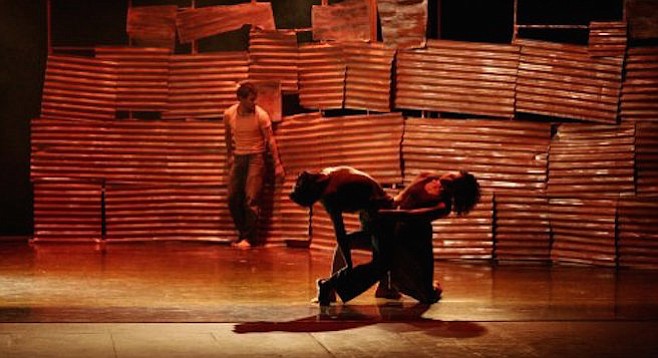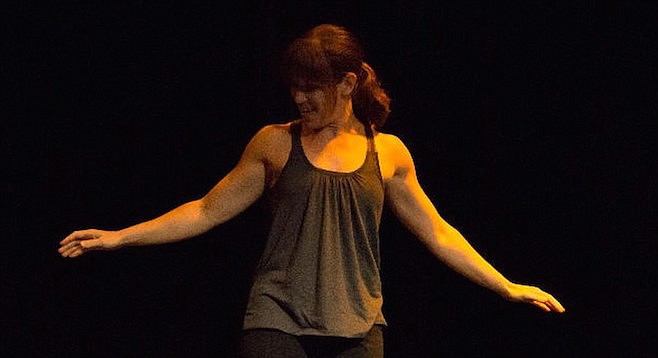 Facebook
Facebook
 X
X
 Instagram
Instagram
 TikTok
TikTok
 Youtube
Youtube

Bodies Are Not Borders. A woman and two men sit with their backs against a stark orange fence patched by sheets of corrugated steel. A second woman, on her back, slides out from a doggy-door-like contraption, upstage right. As cars stream by in the background, she draws white, choppy lines on the black floor with a piece of chalk. She draws them randomly, as if to say, “borders are arbitrary.”
For the first time, The San Diego Fringe Festival is bi-national. As part of the cultural exchange, San Diego sends companies to Tijuana, and companies from Mexico, like Peudulo Cero Danza Contemporanea, come here. In this quintet’s work, we see what it’s like to desire to escape squalor, to wish so badly to be on the other side.
In effect, we witness San Diego from a Tijuana vantage point, and what it means to be the Other — to see what “fringe” means.
The piece has lots of leaps and jumps. And subtle partnering work: at one point a couple is fully committed not to unglue from each other’s waist. The dancers peep through the fence, at times smacking their bare hands against it, providing a fitting, frenzied cadence. Moments of precise synchronicity are sheer relief amidst the madness.
A refreshing addition to the dance repertoire of this year’s festival.
Run concluded.

Men and Juliette. A hostess for Emanary Productions leads us into a room. Unsure of what’s going on, we enter terra incognita and will partake of this performance on our feet, standing and walking about.
We are in a moving museum: dancers create scenarios in a half-dozen yoga- or dance class-like rooms. Here, three men and seven women sit at a dining table, then all thrash silverware violently on the ground. There, a man and woman dance a courtship under an umbrella in a room with pictures of the Statue of Liberty, Big Ben, and the Eiffell Tower. Over there, a man studies himself, and passers-by, with a hand-held mirror.
The program note says the title character is a single female among four siblings. But with Del Mar Tanztheater’s cast of six men and six women, there’s no way to know that’s the case (at the ticket table a woman asked, “is this where Romeo and Juliet is?”). There are no characters or character-building.
This is an autobiographical piece about Juliette’s “growing pains.” Brief moments of group synchronicity provide breathing space for all the individualist thrashing around. The sheer energy and commitment of the youthful cast is the highlight of a piece that still needs tinkering in narrative arc, plot development, and tidying-up of loose fragments.


Bodies Are Not Borders. A woman and two men sit with their backs against a stark orange fence patched by sheets of corrugated steel. A second woman, on her back, slides out from a doggy-door-like contraption, upstage right. As cars stream by in the background, she draws white, choppy lines on the black floor with a piece of chalk. She draws them randomly, as if to say, “borders are arbitrary.”
For the first time, The San Diego Fringe Festival is bi-national. As part of the cultural exchange, San Diego sends companies to Tijuana, and companies from Mexico, like Peudulo Cero Danza Contemporanea, come here. In this quintet’s work, we see what it’s like to desire to escape squalor, to wish so badly to be on the other side.
In effect, we witness San Diego from a Tijuana vantage point, and what it means to be the Other — to see what “fringe” means.
The piece has lots of leaps and jumps. And subtle partnering work: at one point a couple is fully committed not to unglue from each other’s waist. The dancers peep through the fence, at times smacking their bare hands against it, providing a fitting, frenzied cadence. Moments of precise synchronicity are sheer relief amidst the madness.
A refreshing addition to the dance repertoire of this year’s festival.
Run concluded.

Men and Juliette. A hostess for Emanary Productions leads us into a room. Unsure of what’s going on, we enter terra incognita and will partake of this performance on our feet, standing and walking about.
We are in a moving museum: dancers create scenarios in a half-dozen yoga- or dance class-like rooms. Here, three men and seven women sit at a dining table, then all thrash silverware violently on the ground. There, a man and woman dance a courtship under an umbrella in a room with pictures of the Statue of Liberty, Big Ben, and the Eiffell Tower. Over there, a man studies himself, and passers-by, with a hand-held mirror.
The program note says the title character is a single female among four siblings. But with Del Mar Tanztheater’s cast of six men and six women, there’s no way to know that’s the case (at the ticket table a woman asked, “is this where Romeo and Juliet is?”). There are no characters or character-building.
This is an autobiographical piece about Juliette’s “growing pains.” Brief moments of group synchronicity provide breathing space for all the individualist thrashing around. The sheer energy and commitment of the youthful cast is the highlight of a piece that still needs tinkering in narrative arc, plot development, and tidying-up of loose fragments.
Comments